For those of you that asked, and have nothing to do for the next ten hours, this post is my long-winded and unprofessional recap of how we (along with my wonderful parents) DIY’d our patio and took the space from THIS:
To THIS: (you can see more glamour shots in my initial post here)
We had started digging out the area in question (oh so leisurely) over the course of the summer, but things really started to gear up around the end of July. We got the area mostly dug out by early August, which is when we got our quote (for over 8k) for a professional patio. We thought it would be cheaper because we already dug it out, but NO! So, we ordered our materials and had everything delivered on August 14th. We also had a big party planned for August 29th! It was tight, but we made it in time. Here are the steps we took:
Plan it! We drew a diagram of the area we wanted to pave, noting our big ole A/C unit that we would have to go around. See the following 'Microsoft Paint' rendition of the area, totally not to scale and looking like a 5-year-old did it:
To deal with the huge A/C unit, we decided to do a width of 9 ft near the sunroom door, and a larger width of 11.5 ft after we got past the beast. The total length of paved area was going to be 30 feet. We went to the stone yard with our measurements, and picked out our pavers - a beige and red cobblestone combo from Belgard. The dealer there wrote out everything we needed, he was definitely the expert when it came to supplies and quantities needed. Don’t try to tell them how much you need...even though 11 tons of gravel sounded outrageous, we used it all!! Note for planning your patio shape: curves are hard. Straight lines are easy. Keep it easy. Just sayin.
Prepare it! Contact your local utility companies before you begin excavation! We didn’t, and that was STUPID, even though we didn’t hit anything. We drew out our paving area with spray paint, going a bit larger than what we were actually going to pave because you will always lose some area when you start laying down the edgers. Then Shaun rented a (manual) sod cutter, and got sweaty with it for an afternoon. It was intense and backbreaking to get all the grass out. The sod cutter is much nicer than just using a shovel, because it takes out the grass in a nice even depth and width, where a shovel takes out uneven chunks. But it was still manual labor! Oh, and it was a nightmare to get rid of the huge pile of sod. Most dumps don't take it. I'll spare you the details of that drama.
Dig it! We followed the recommendation from Belgard to determine our depth. Where there is only pedestrian traffic, a base of 4”-6” of processed gravel is recommended. To achieve this, excavate 7”-9” to allow for base material (we used 6”), sand (we used 1”) and pavers (they are 2.5” thick). You want your patio to be above the ground about .5 inches to allow for drainage. Once we determined our 9 inch depth, it was time to get DIGGY with it.
The digging went on for days and days. Sometimes neighbors came over to help, sometimes family came over to help, but it was mostly us two cursing at the thick clay dirt we were pulling out. And, we had to mound up all 11 tons of dirt behind our garage….we had people coming for free dirt (thanks to a Craigslist ad) for weeks. A couple wheelbarrows are very necessary for this part! Measure your excavated depth carefully, because you don’t want low or high spots. In no way do you want your pavers to be beneath ground level! We made sure our hole was even everywhere by staking a string across the entire width every couple feet, then using a tape measure to make sure we were at 9 inches the entire way.
When we were high, we dug more dirt out. When we were low, we added some. THIS TAKES FOREVER BUT IT IS VERY NECESSARY! Also in this pic is one of the cubic yard 'tote bags' that the gravel and sand came in. They were a lot nicer than having piles of stuff right on the grass!
Rock it! Compact the surface of the excavated soil with a plate compactor (we rented one for a week, $200).
For small areas a hand tamper works great, we used one of these for getting into the corners, and ‘perfecting’ the sand later on in the process. Fill the excavated area with your crushed stone approximately 5” thick, use your strings to measure how high the gravel is. Yes, this is the labor-intensive part where you wheelbarrow your shiny happy butt back and forth from the piles (or tote bags) to the pit over and over. If we were lucky, we could've had the delivery guy dump it all right into the pit, however our driveway and the opening to our neighbors driveway was too narrow for his skid steer to fit into our back yard. So, it all got dumped on our grass in the front yard and we hoofed it the entire time. BOGUS. We hired a guy to help with this part, it was so worth it.
Compact it with the plate compactor, wetting the gravel lightly if needed. When you can walk on the gravel without causing an indentation, you can add more gravel until you are at 6 inches thick (3 inches from your string) and compact again. Try to slope the surface for water drainage, but you can also do a little of that with your sand layer too. The slope should be 3/16" per foot, nothing dramatic or visible to the eye. Use your strings and tape measure, or you can use a line level on the string to determine the slope. A note about the compactor – it only goes forward, not backward. So for those tight spots where you can’t continue going forward, use the hand tamper or you will mess up your gravel!
Edge it! Edge restraints should always be used to prevent the pavers from spreading. You can use PVC, aluminum, concrete, pressure-treated wood, a ton of different things, but we went with the heavy plastic edging strips that the dealer sells. They should be flush against the compacted gravel. There was a lot of ‘playing around’ with the edging as we were installing the pavers. We would pound a couple stakes through them, then adjust them and fully pound all the stakes in after the pavers were laid.
Uh, Sand it! (there's really no cute directive for this step) Here is the official way to put in the sand: Place 1” (outside diameter) pipes 6’ to 8’ apart down the area to be paved. Measure the distance from the string lines and the screed rails at several points and adjust the height of the rails by putting sand under them or trimming the base underneath if too high. Hand pack sand around the rails to hold them in place. Spread 1” of sand between the rails until it is slightly higher than the rails. Use a 2” x 4” board to drag across the top to smooth and level the surface. Fill in the low spots and repeat. Remove the rails and fill in the indentations with sand, and trowel smooth as you are laying the pavers. Do not step on, compact or wet the sand after you have finished screening.
Here is what we did: Dump in sand. Play with sand until smooth-ish. Make sure sand level is 2 inches from string all around. Start laying pavers and add or take away sand as needed. It takes forever, but we had a very sloped side yard and the screening just didn’t work for us, we had to adjust the sand for each individual paver separately, using a level. UGH. Here we are playing with paver patterns, edgers and sand levels to get the hang of it:
ps - those are my dad's feet. What is it with dads and bright white sneakers?
Pave it! Starting in a corner, lay the pavers in the pattern you have chosen. We worked in rows, and because we chose pavers of varying lengths, we were able to work it out so we didn’t have to cut anything. SCORE! Leave a 1/8” space between pavers so there is room for sand. Periodically check the outside edges of your rows to make sure they are straight. We knew we wanted the patio to be the same distance from our house/garage the entire length, so we used a 2x4 with marks drawn on it and held it against the house to see if we were on track. This is another reason you want your edgers to be moveable, because sometimes you will need to tuck it in closer or move it out a bit to get that straight line you want.
To progress from one row to the next, we placed the pavers and then checked out with a level how it related to the previous row. We used rubber mallets to pound them in tight. Every few rows, we would put a long board on the finished area and slap a level on it to see how level/sloped we were. There was LOTS of adjusting. The process of laying the pavers took so many days, it was crazy. Sometimes we would find one whole row was too low, and out came an hours' worth of work. That is where the beer came in.
Cut it! We didn’t have to cut any pavers, but if you do, you will want to rent a diamond blade wet saw. You can use a paver splitter or a hammer and chisel, but you run the risk of breaking your pavers. If possible, keep edge stones to one half paver because smaller pieces are too vulnerable to cracks and aren't a good idea. We edged with 4x8 pavers set in a 'soldier row', and we made the patio just as long as 95 full pavers were, so we didn't have to cut. Does that make sense?
Set it! Sweep the surface to remove any debris. Spread polymeric sand over the surface, sweeping it into the joints. You can compact the surface again if you like, but we didn’t - and don’t feel it is necessary because we did such a good job of leveling everything and really pounded the pavers down. Keep going until all the joints are filled, and try to make sure there isn’t any big clumps of sand on the surface of the pavers because polymeric sand dries to a hard finish. Don’t just use playground sand! Polymeric is what you want because it hardens and won’t let weeds grow in between the joints!
Wet it! After you get all the sand into the joints, sprinkle the entire area with the hose. Do not use the ‘jet’ spray! You just want to get it wet to activate the hardening qualities and then you have to let it set up. Keep rain off the patio for at least two days, or it could wash away the sand. We had tarps on our patio for three days until we finally got some sun!
Still to do! As you can see in this pic, the seat wall stones are just dry-laid for now. We ran out of steam before we could finish, so that will be a project for next year. We need to configure the stones the way we want them, cut a bunch in half, and then use the concrete adhesive to make it all solid. For now, they are safe to sit on but I don't tend to sit outside during WI winters, so it doesn't really matter anyway. This is also a close-up of the polymeric sand in the joints, it looks really solid once it dries.
But what did it cost ya? Here is our invoice breakdown from the stone yard:
230 sq ft Belgard Dublin 4 piece Brittany Beige 575.00
60 sq ft Belgard Dublin 4 piece Brownstone Red 150.00
53 sq ft Belgard stone 4 x 8 Brownstone Red for edging 132.50
60 Belgard Weston universal wall sandstone/25 Bannockburn red 186.00
5 – 10.5 tubes concrete adhesive (for seat wall) 21.50
10 – 8’ pieces beast edging 115.00
80 – 10” edging spikes 36.00
3 – bags tan polymeric sand 72.00
11 ton ¾” crushed limestone “traffic bond” (in tote bags) 220.00
2 ton torpedo sand (in tote bags) 40.00
2 – forklift deliveries to Racine 340.00
Total for stone yard supplies: $2100 minus refund for totes
Then we paid for separately:
Compactor rental 200.00
Help with gravel 100.00
Total for extra expenses: $300
Then I made it pretty:
Patio table - $140
6 patio chairs - $300
End table - $40
6 throw pillows - $40
6 seat cushions - $60
Umbrella - FREE gift from neighbor (thanks, Margo!)
50 pound umbrella stand - $85 and worth every penny
Fire pit - $100
Total for decor: $765
$189 was refundable when we returned the pallets and tote bags to the stone place, however we are dumb and didn't realize they wanted the pallets back. Instead, we spent an entire day cutting them all up and trying to find places to put them, how to throw them in the trash, etc, etc. DON'T BE THAT STUPID!!! Actually read your invoice! We only got $90 back for the tote bags.
**Grand total: $3165**
Supply list: Beyond what was given to us by the stone yard, we used very basic tools for this project. The compactor and sod cutter were the only rental items. The rest were:
shovels
wheelbarrows
boards to use as ramps
boards to use for leveling and measuring purposes
rubber mallets
3 pound hammers to drive in the edging stakes
twine for measuring
gardening stakes for attaching the twine
levels
tape measures
screwdrivers for lifting up pavers that were already installed
rake for smoothing sand
buckets for toting around extra sand and gravel as needed
knee pads
booze (yes, this was a requirement for me most nights)
Bottom line: It was a ton of work. We yelled. We cried. We almost redid the entire thing a couple times. It is not perfect. There are a couple low pavers, but we can dig them out and redo if we want. We are extremely happy that we did the entire project for $2400 (not including the furniture and decor) instead of $8200! Our edges aren't completely wave-free, but grass will grow and no one will see that. All in all, I would do it again in a heartbeat. Just don't ask me to help with yours! Not in person, anyway :)
THANK YOU Mom and Dad for all your help with this patio!
Home Style Saturday 481
22 hours ago



















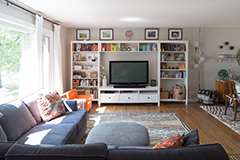

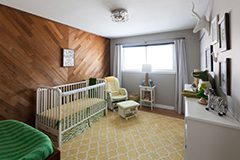
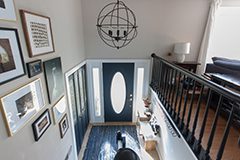
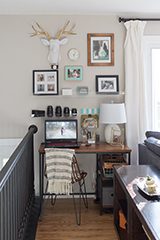

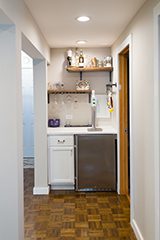
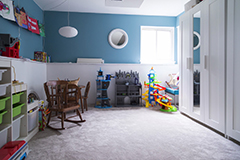
Thanks so much for the step-by-step explanation! This looks amazing, but you already know that! COngrats! Love the blog and your fab writing style.
ReplyDeleteOh no, a new blog I must follow! :) I just checked out your stairway renovation... brought back nightmares. I still have to somehow get paint off of my stairs from paiting the risers. I was going to paint my bannister black, but I got so behind that I just decided to keep everything white. After seeing yours, I might have to break out the black paint and have a go at it. :) Great work on all of your renos!
ReplyDeleteOh, this is your SIDE YARD??!!!???
ReplyDeleteThat's phenomenal!
You two are SO lucky for your awesome new patio and backyard full of nice green grass. I definitely miss that about the east coast.
Thanks for stopping by the blog- I do love our patio view, but I would take a yard over a view if I had the choice! (Maybe one day).
(I mean, not that you live on the east coast, but that is where I'm from, and, you know, we had a yard. Not like L.A.)
ReplyDeleteThis seems like such an insane amount of work. I give you and your handyman SO {sosososososososo} many kudos! I'm exhausted just from reading it. Looks great though; well worth the effort!!
ReplyDeleteYou did a great job guys! It cost us a little bit less just to have the patio from hell demolished :P Then we'll have to pay more money to have a new deck built. Ughhh....
ReplyDeleteIt looks like one of those backyards you would see on HGTV! Your hardwork paid off. Love the cooler with beer!
ReplyDeleteHoly guacamole - you should be very proud of yourselves! Amazing!
ReplyDeleteWOW, and I thought we've done some back-breaking projects! No wonder you needed alcohol to get you through it! Kudos to you both... very impressive!!
ReplyDeleteHey, you did an awesome job! If you like my blog I would love for you to share it on the your haunted blog list! Spread the blog love ;) http://recklessbliss.blogspot.com/
ReplyDeleteI love your blog, it's so much fun!
Thanks for the breakdown and how to!! We need to remove our ugle patio and startover! This gives me hope
ReplyDeleteSo... if you had to do it again, would you do it the same way?
ReplyDeleteI built the patio under my pergola with bigass pieces of flagstone (like a jigsaw puzzle with 100lb pieces) but for the new house, I'm thinking I'm going to frame up all the patios, use poured concrete and stamp them.
DIYdiva - Yeah, I would do it the same. Stamped concrete doesn't really do well in WI, concrete slabs in general crack 100% of the time up here. Plus I love the look of the cobblestone pavers. What I would do differently is rent machinery to dig up the yard, and pay someone to haul away all the sod and dirt! That was a nightmare I'm not yet recovered from.
ReplyDeleteWow, you rock big time! Thanks for writing such a detailed post (especially with the budget breakdown)- I'm bookmarking it so that I can come back when I begin work on my backyard :).
ReplyDeleteThis is spectacular. I want one. Bad. Don't know if our marriage could survive that one, though. ;)
ReplyDeleteThis is a great post! My wife and I are in the process of excavating for an ENORMOUS patio (650 sq ft) and it's good to see we aren't alone in the frustrations and problems we've encountered. One question I have is the compactor. It looks like the one we can rent from Home Depot weighs 190lb. How the &$*# did you get that thing to/from your house?
ReplyDeleteThe one we rented didn't weigh nearly that much, mabye 60 lbs? I have no idea why the one you saw is so heavy!
ReplyDelete